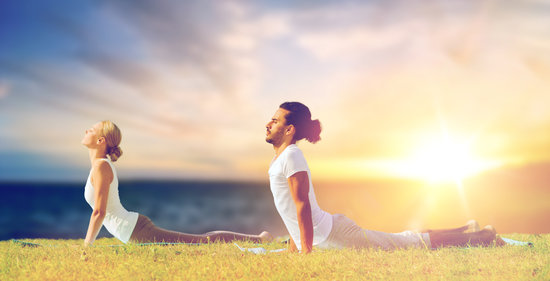
I like to do warm-ups
I like to do warm-ups at the start of my own practice, & in a class. When I first learnt yoga, they were called flexibilities.
For beginners
For a beginner class, I do quite a few flexibilities, because they help a person do the actual postures.
And those more advanced
For an advanced class, I use the poses with bhastrika here. Often, I'll do a standing twist to start, moving rapidly, from side to side, blowing the air out forcibly as I twist...not mukha bhastrika, just blowing. This really loosens the body.
Cats for deep breathing
Sometimes I start with child, then cat. As we perform cat pose, we quite naturally do deep breathing on the inhale, & with a big squish at the end of the exhale, we are forcing air out of the lungs. Then when we breathe in again, we breathe deeper still.
So this is good for anyone who has:
- been unwell
- a beginner
- asthmatic
In/brief pause; out/brief pause.
It sets the scene for deeper, relaxed breathing in a class. And this in turn, relaxes emotions, & mind.
Then I get ratios going:
- for beginners, people with small rib cages, breathing problems: use in/4 counts; hold in/2 counts; out/4; hold out/2
- next is 6:3:6:3
- then 8:4:8:4.
- most people find the 8:4 ratio enough.
- generally, people prefer the 6:3 count, especially women.
I advise counting to a heart beat rhythm, as it's very harmonious.
Doing child, before cats, after, or both, also aids breathing due to it's restorative effect on the adrenal glands.
Tiger pose for breathing
For a thorough effect on improving lung health, doing asanas where we create a compression action, is also helpful. the easiest way to do this is the tiger pose:
- on all fours, exhale as you lift 1 leg up behind you
- inhale as you bend the knee forward towards the head, rounding the back.
Teacher tip
I really want to be clear that people with small lung airways, asthmatics, emphysema, people prone to bronchitis, people who are, or have recently been, smokers, they should not be given too much of cat ratios, & tiger, at once. Build up lung health slowly.
Unless a yoga teacher has had medical or physiotherapy training, they are yoga teachers, not therapists! So, take care, & keep the ego out of it. If a student has a real breathing problem, they need to find out from their doctor what they can & can't do, & may need to be referred to a physiotherapist.
Although I have 40 years experience teaching, & a lot of knowledge & experience with applying yoga to various problems, I know that I do not have the knowledge nor training of a medical person nor a physical therapist.
Other poses aid breathing, too
Some postures force air into various parts of the lungs, just by virtue of moving into the pose, & holding it:
- cobra pose/bhujangasana is a must for me, because it pushes air into the bottom part of the lungs
- as does the camel/ushtrasana.
I like to rest in child after the camel, which of course is the obvious counterpose, but a great child variation is to cup your chin in your hands, with elbows on the floor. This forces air into the mid-lungs.
You can also add this
Then, for those with no neck or shoulder problems, put your hands flat on the floor either side of the head, in the usual child, push hands into the floor & roll onto your crown. You can do this dynamically: roll up; roll back to child, then hold the last time, in the pose, which is sometimes called the hare pose, sometimes known as pranamasana.
Going up & down in the pose, forces air into the small top part of the lungs. Rest after in child. This whole sequence is highly beneficial for the lungs.
Standing poses
With standing poses, each time you raise the arms out to the sides, you are creating an action which forces air into the side parts of the lungs, an area often overlooked. You are creating an expansion. When we do trikonasana/triangle, we are strengthening the diaphragm, thereby improving lung health.
Twists force air into 1 lung lobe, we have 2 lobes, a left & a right one. Holding a seated twist is the easiest way to do this.
The postures themselves, do much of the work of lung improvement.
Comments
Post a Comment
You can leave comments here - comments are moderated for the time being.